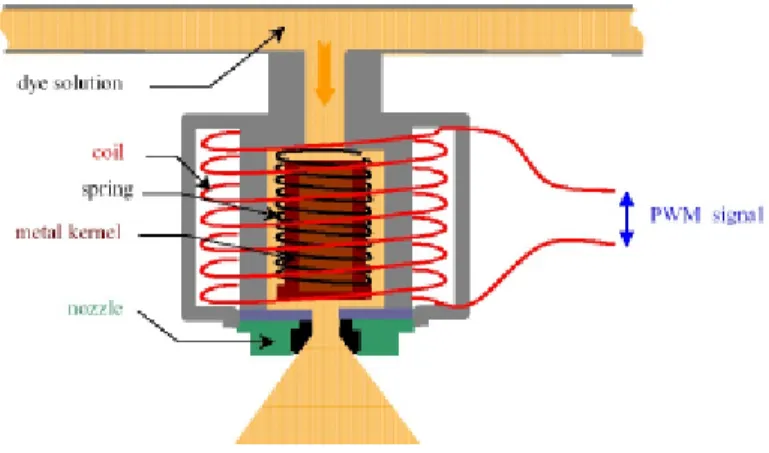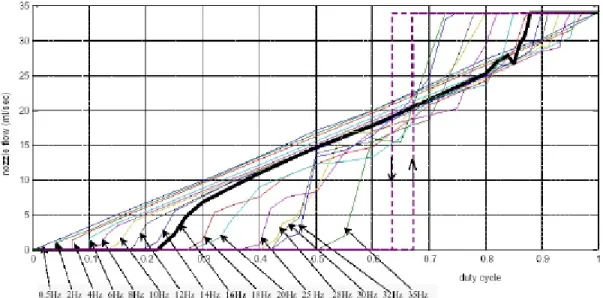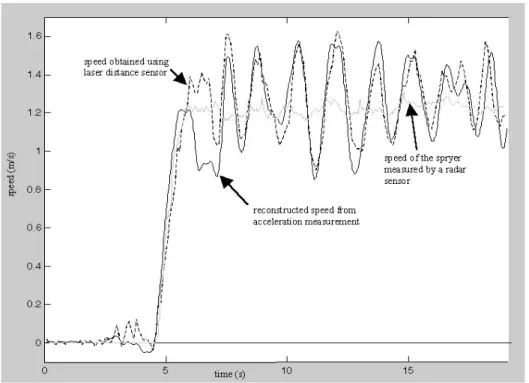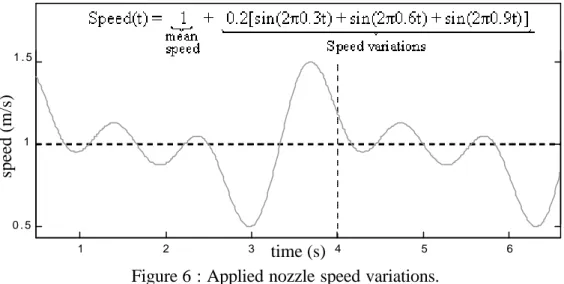A
G
E
NG
EurAgEng
BUDAPEST2002
Paper Number:
Title:
Authors:
Summary:
Longitudinal spray distribution is mainly affected by the horizontal speed variations of the nozzles. Manufacturers classically try to reduce unwanted nozzles movements using horizontal boom suspension but these methods show performance and price limitations. The purpose of this paper is to propose a spray controller aiming to compensate the effect of the horizontal boom movements on the spray distribution besides the effect of tractor speed variations. The controller is based on three main parts: a control law describing the relationship between nozzle speed, nozzle flow and spray coverage; a real time measurement of the boom horizontal speed variations using micro-machined capacitive accelerometers and Pulse Width Modulation (PWM) no zzle flow actuators. A prototype was developed using a processor board controller (dSpace) and tested on a laboratory test bench. The nigrosine solution spray coverage was measured using image analysis for field representative multi-sine nozzle speed variations. The spray coverage uniformity using the spray controller showed about 51% compensation of the spray coverage variations observed without controller.
Purpose
Chemical spray application remains the main way to insure the high yields at low cost 02-PM-020
SPRAY CONTROLLER FOR HORIZONTAL BOOM
MOVEMENTS COMPENSATION
El Bahir L.(1), Lebeau F.(*) (2), Destain M.-F. (2), Kinnaert M. (1), Hanus R. (1)
(1)
ULB CP165/55 Av. F. Roosevelt 50, 1050 Brussels Belgium +3226502675 (2)
FUSAGx LMA Passage des Déportés 2, 5030 Gembloux Belgium +3281622164 elbahir@labauto.ulb.ac.be, lebeau.f@fsagx.ac.be
of the conventional agriculture. However, the increased concern about the
environmental pollution and about the effect of pesticides residues on human health creates a strong need for more efficient application methods. Indeed, to insure pesticides efficacy, applicators trend to increase the mean doses to avoid the detrimental effect of local under-application resulting from spray deposition variations.
Many device have been developed to insure spray coverage uniformity for agricultural boom sprayers. Spray controllers were developed to compensate the effect of sprayer speed variation. Boom suspension were developed to limit the transmission of
agricultural ground solicitations to the nozzles [Frost et al, 1986], [Nation, 1987]. Vertical boom suspension try to insure optimal height between the nozzles and the crop while horizontal boom suspension aim to limit relative nozzle speed variations with regard to the mean sprayer speed.
The horizontal suspensions are especially needed for the increased boom width of present sprayers. Most manufacturers have adopted passive suspension that efficiently reduce the problem but our recent field trials [FUSAGx, 2002] typically showed, in the 0.2 - 1Hz frequency range, a mean nozzle speed coefficient of variation (CV) of 6% for the all boom, while the CV reached 15% for nozzles located at the end of the boom. The horizontal speed variations of the nozzles mainly affect the longitudinal spray
distribution. This problem is of particular importance as repartition obtained with widely used flat fan nozzles is especially sensitive to the speed variations.
The development of active horizontal suspensions is needed to further increase their efficacy but some practical limitations and cost considerations limit their potential. Therefore, it was proposed to use a controller acting on the hydraulic circuit of the sprayer to reduce the effect of horizontal boom movements on the spray distribution.
Method
Conventional spray controllers which are designed to compensate the tractor speed variations do not take into account the unwanted horizontal boom movements that have the same kind of negative influence on the spray distribution. The idea was to improve the precision of such controller by acting at the nozzle level rather than at the sprayer level.
To design such a controller, three main parts are needed:
1. Control law:
The control law describes the relationship between the nozzle speed, the nozzle flow and the spray distribution. This law can be used to calculate the nozzle flow needed to produce an uniform spray distribution in the presence of nozzle speed variations. The easiest form of the control can be described by the following equation:
( ) ( ) ( )
d d
q t =kτ V t (1)
Where τd is the desired spray coverage
qd(t) is the flow setpoint needed to get τd
V(t) is the absolute nozzle speed k(τd) is a constant depending on τd
( d) d
k τ =ατ (2)
The constant α can be experimentally evaluated for a nozzle by measuring the spray coverage obtained for a set of trials at constant speed and flow.
2. Real time measurement of the boom movements:
Several methods have been developed to measure boom movements; distance, speed and accelerations sensors were used depending on the application. Acceleration measurements were chosen as they are most suited to detect speed variations.
The quality of the measured nozzle speed in real time is of a crucial importance for the correct determination of the flow setpoint delivered by the controller. While the mean speed of the boom is measured using radar speed sensor, the reconstruction of the relative speed variations of the boom is based on the measurement of the boom accelerations [Lebeau et al., 2000]. Speed determination from accelerometer measurements requires on one hand the filtering of the unwanted low and high
frequencies and on the other hand integration of the signal. Furthermore, for economical considerations, the number of accelerometers can be lower than the nozzles number so that nozzle speed interpolated from nearby sensors measurements may reduce the quality of the estimated speed of a particular nozzle.
3. Nozzle flow actuator:
The nozzle flow actuator has to operate at the nozzle level in such a way that both high frequency capability and nozzle flow individualisation can be insured. Pulse Width Modulation (PWM) flow actuators developed for precision farming satisfy the requirements [Giles et al., 1990]. Figure 1 presents the principle of such an actuator.
Figure 1: PWM actuator
A metal kernel can be moved to open or close the nozzle under the effect of the
electromagnetic force inducted by an electric current in the coil. The flow of the nozzle can be controlled using a PWM signal by varying the ratio of the opened position duration versus the closed position duration at high frequency. This frequency is called the PWM frequency while the ratio is called the duty-cycle. For such actuators, the actuator static characteristics can generally be described with the following linear equation:
Where a and b are constants; qr is the nozzle flow; duty is the PWM duty cycle.
Implementation and experimental set-up
The practical structure of the controller parts described in the previous section are described in figure 2.
Figure 2: Practical structure of the controller
Sensors:
Micro- machined capacitive accelerometers CXL02LF3 (Crossbow) were chosen as their frequency range [0 - 125 Hz] and intensity [± 20 m/s²] is suited to that of the boom movements in the most detrimental frequenc ies for the spray distribution. Furthermore, this low cost technology offers a sound solution to commercial
considerations. A RGSS-201 radar tachometer (Philips automotive electronics Co) was chosen to measure the mean sprayer speed.
Controller board:
The controller was implemented using Simulink (Mathworks) models and a DS1102 cardboard controller (dSpace).
The sensors signal processing constitutes the first step of the controller task. Acceleration signals of different sensors are combined as a function of the nozzle location on the boom to get a good estimation of its relative acceleration. The resulting signal is further integrated and filtered to get an estimation of the relative nozzle speed. The need for a real- time filtering of the signal limited the filter order to avoid
excessive phase distortion. Therefore a first order 0,15 – 10 Hz band-pass Butterworth filter was chosen. Lower frequencies were not taken into account as they correspond to limited speed variations of the boom. Higher frequencies were neither taken into account as they have a limited impact on spray distribution. The pulse signal of the radar is adequately processed and low-pass filtered. The absolute speed of the nozzle is obtained summing the sprayer speed and the relative speed.
In the second step, the actuator static characteristic (3) is integrated in the control law (1)-(2). The absolute speed is transformed using the resulting equations in a PWM control signal that is later amplified to act on the PWM nozzle.
Actuators:
The flow of the nozzle depends on the PWM duty cycle and frequency. This relationship represents the actuator static characteristic, (1). Figure 3 presents the measured characteristics of the actuator equipped with a Teejet XR 11005 nozzle for several PWM frequencies at 2.6 bars. It appears that the linear part, equation (3), located at the centre, decreases with the increasing PWM frequency.
Figure 3 : Actuator static characteristics
16 Hz PWM frequency (bold) was chosen with corresponding constants a and b, equation (3), in the sequel. Indeed, a high PWM frequency is needed to assure the continuity of the spray coverage while sufficient linearity is needed. Trial conducted to determine the dynamic of the actuator showed bandwidth being only limited by the PWM frequency.
The spray controller was tested on a test bench (figure 4) constituted of a linear translation table to simulate the nozzle speed variations, an hydraulic circuitry to supply the nozzle with a 0.3% nigrosine solution and a paper spray collector attached on a conveyor for spray coverage measurements using image analysis of scanned paper.
Figure 4: Test bench used to test the controller
Results
The controller performance was tested in two stages. First, the reconstructed absolute speed measurement of the nozzle was compared with a measurement performed using a laser distance sensor. The trials were performed on a highly vibratory hard uneven meadow. An illustrative example is presented in figure 5. The small discrepancies appearing just after the starting caused by the high acceleration of the sprayer rapidly disappear after what the signals are similar.
Figure 5. Comparison of the reconstructed speed signal with lased measured speed. The second stage was performed on the test bench. An accelerometer was mounted on the horizontal linear translation table. The sprayer mean speed was replaced by a constant 1m/s signal corresponding to the conveyor speed. The desired spray coverage was fixed to the one obtained with 0.5 duty-cycle and 1m/s mean speed. A multi-frequency solicitation (figure 6) was applied to the nozzle by the linear translation table, reproducing the worst combination of sprayer boom movements observed in field measurements.
1 2 3 4 5 6 0 . 5 1 1 . 5 speed (m/s) time (s)
Figure 6 : Applied nozzle speed variations.
Results showed about 51% compensation of the spray coverage variations (figure 7). The actuator was found suitable for this application. The controller was found effective in the most detrimental frequencies, but it is observed that the spray coverage has been lightly overcompensated. Trials conducted at different constant speed between 0.5 and 1.5 Hz with corresponding duty-cycle to insure constant dose proved dose - spray coverage relation being not linear with duty-cycle, what explained most of the discrepancies. 0 5 0 1 0 0 1 5 0 2 0 0 2 5 0 2 5 3 0 3 5 4 0 4 5 5 0 5 5 6 0 6 5 7 0 Length (in) Spray coverage (%) Without controller With controller
Figure 7: Comparison of spray coverage with and without controller.
Conclusions
The spray controller shows promising results to limit the effect of sprayer boom movements on spray distribution. An industrial prototype must be developed to conduct field trials. It should be designed to work in combination with PWM
electronic spray controllers designed for precision farming in order to be implemented on future generation of spray controllers.
Bibliography
Giles D K ; Comino A (1990). Droplet size on spray pattern characteristics of an Electronic Flow
controller for Spray nozzle. Journal of Agricultural Engineering Research. 47, 249-267
Lebeau F; Destain M-F (2000). Sensor data fusion for the measurement of horizontal sprayer boom
displacement. Proceeding of the 1st International workshop on noise and vibration in agricultural and biological engineering, ISMA 25, Leuven, Belgium, 1615 - 1618
Frost; Sullivan (1986). Verification of a model for a passive spray boom suspension. Journal of
Agricultural Engineering Research 94, 245-255
Nation H J (1987). The design and performance of a grimbal-type mounting for sprayer booms part 1:
Development procedure. Journal of Agricultural Engineering Research 36, 233-246
Nation H J (1987). The design and performance of a grimbal-type mounting for sprayer booms, part 2:
optimisation model and validation. Journal of Agricultural Engineering Research 36, 247-260 Acknowledgements
This research was funded by the Belgian Ministry of Small Enterprises, Traders and Agriculture.




